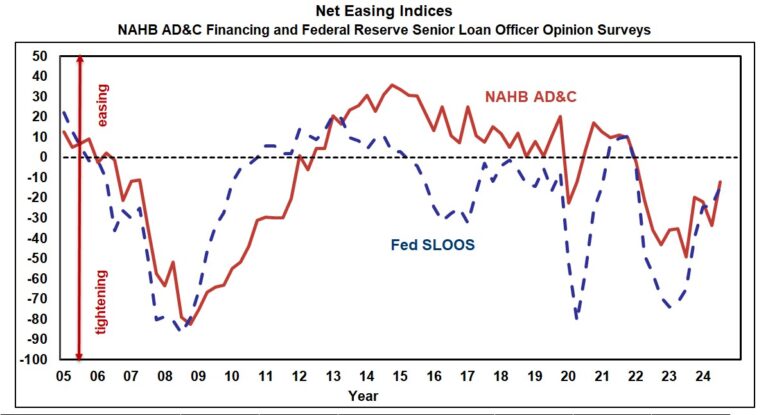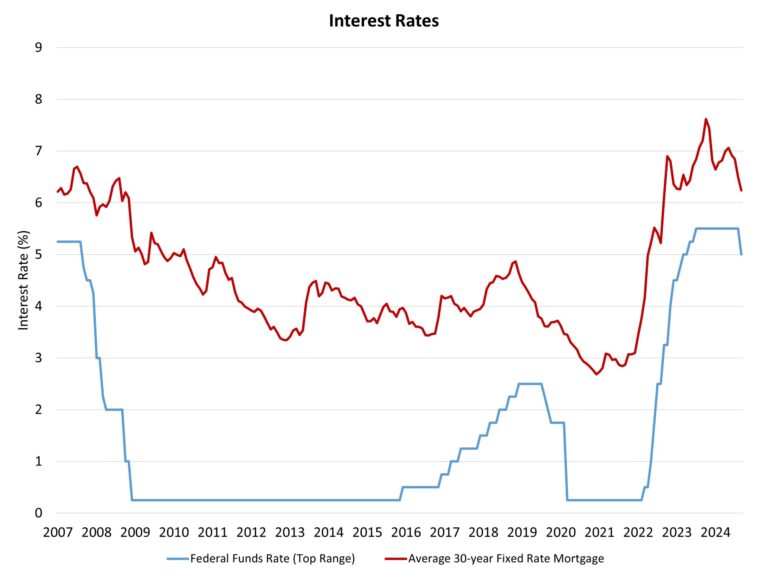After its first post-COVID rate hike enacted more than two years ago, the Fed’s Federal Open Market Committee (FOMC) announced at the conclusion of its September meeting a significant reduction for the short-term federal funds rate. Tight monetary policy was undertaken to fight the worst bout of inflation in four decades. Today’s policy action marks the beginning of a series of rate decreases necessary to normalize interest rates and to rebalance monetary policy risks between inflation (risks decreasing) and concerns regarding the health of the labor market (risks rising).
The FOMC reduced its top target rate by 50 basis points from 5.5% (where it has been for more than a year) to a “still restrictive” 5%. This was a larger cut than our forecast projected. In its statement explaining the change of policy, the FOMC noted:
“Recent indicators suggest that economic activity has continued to expand at a solid pace. Job gains have slowed, and the unemployment rate has moved up but remains low. Inflation has made further progress toward the Committee’s 2 percent objective but remains somewhat elevated.”
With the above-noted progress for inflation, today’s action is the beginning of a series of federal funds rate cuts, which ultimately should decrease the top target rate to approximately 3% in the coming quarters, as the rate of inflation moves closer to the target rate of 2%.
The pace of these future expected cuts is somewhat open to debate. Fed Chair Powell noted in his press conference that if weakening conditions require it, the Fed can move quickly. The central bank can also move more slowly if inflation and macro conditions require a more gradual transition.
The Fed’s policy statement declared, “The economic outlook is uncertain, and the Committee is attentive to the risks to both sides of its dual mandate.” The Fed also noted, “In considering additional adjustments to the target range for the federal funds rate, the Committee will carefully assess incoming data, the evolving outlook, and the balance of risks.”
As stated, today’s policy move reflects that the Fed has shifted from a primary policy focus of reducing inflation to balancing the goals of both price stability and maximum employment (with perhaps a greater concern being the labor market). This is due to the fact that inflation continues to moderate. Keep in mind, inflation does not need to be reduced to the central bank’s target of a 2% growth rate for the Fed to cut further. Rather, inflation just needs to be on the path to reaching that goal (likely in late 2025 or early 2026).
The Fed also published an update to its economic projections. The central bank is forecasting a slowing economy but no recession in the coming quarters, with GDP growth rates of 2% for 2025 and 2026 (measured as fourth quarter over prior fourth-quarter growth rates). The unemployment rate is expected to rise but average a nonetheless relatively low level of 4.4% in 2025 before declining slightly in 2026.
The economic projections imply an additional 50 basis points of rate cuts for 2024 (perhaps 25 in November and 25 in December), followed by 150 more in 2025 and 2026. This FOMC projection implies a terminal federal funds rate for this cycle of approximately 3%, consistent with our forecast for the medium-term outlook.
While markets have priced-in a good deal of the current, expected monetary policy path into long-term interest rates, including mortgage rates (which have fallen from 6.7% to 6.2% in the last six weeks), the more immediate effect for housing of today’s rate reduction will be seen in builder and land developer loan conditions. Interest rates for such loans should move lower by approximately 25 to 50 basis points in the coming weeks.
A reduction for the cost of builder and developer loans is a bullish sign for housing affordability. The pace of overall inflation has remained higher than expected in recent quarters due to the growth of housing costs and elevated measures of shelter inflation, which can only be tamed in the long-run by increases in housing supply. Chair Powell noted it will take some time for rent cost growth to slow.
We have argued that higher short-term interest rates have prevented needed construction by increasing the cost and limiting the availability of builder and developer loans, thus harming shelter inflation. However, as Chair Powell himself stated, there are other factors holding back housing, including a lack of efficient zoning and other issues that are limiting supply, and the Fed cannot fix those issues. But I continue to argue that lower rates for builder loans will help, as homebuyers, renters and other housing stakeholders wait on state, local and federal governments to enact more effective regulatory policies.
Discover more from Eye On Housing
Subscribe to get the latest posts sent to your email.


